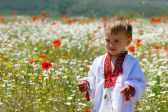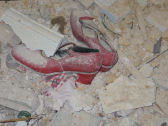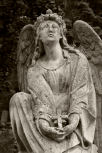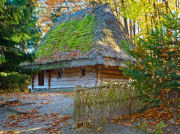
Contents on this Page
Holodomor Education and Awareness
Each year in November many Manitobans and school communities commemorate National Holodomor Memorial Week occurs during the fourth week of November, and International Holodomor Memorial Day is recognized on the fourth Saturday of November. For information and resources for commemorating the Holodomor see the annual Holodomor Memorial Day Pamphlet (in French and in English) published by The Holodomor Research and Education Consortium (HREC).
Educators and Faculty of Education candidates who teach or have taught at the primary, middle years or senior years levels are invited to apply for the HREC Educator Award for Holodomor Lesson Plan Development. This annual award is a project of the Canadian Institute of Ukrainian Studies, University of Alberta. The award is intended to foster the development of innovative, creative and interactive lessons for grades K-12 that develop critical thinking skills while addressing the topic of the Holodomor, and to recognize the outstanding educators who create them.
Individual awards will vary up to but not exceeding $2,000.00 CDN based on the quality of submissions.
More information regarding the educator award is available online at: HREC Educator Award for Holodomor Lesson Plan Development
Introduction
 Our society is composed of people from diverse linguistic and cultural origins. It is important that all Manitobans have a good understanding and appreciation of the richness of our human diversity, our roots, and our people’s stories, in order to develop a sense of community and intercultural understanding. This should include an awareness of how issues of contemporary oppression and inequality are rooted in our history.
Our society is composed of people from diverse linguistic and cultural origins. It is important that all Manitobans have a good understanding and appreciation of the richness of our human diversity, our roots, and our people’s stories, in order to develop a sense of community and intercultural understanding. This should include an awareness of how issues of contemporary oppression and inequality are rooted in our history.
Within this context, it is important that all students know and understand some of the more important aspects of the Holodomor. The Holodomor and other examples of genocide are of enduring significance to Canadians and the world as a whole because there are important lessons to be learned about human rights and responsibilities, oppression, and the challenge of democracy in multi-ethnic and multicultural societies.
The Meaning of the "Holodomor"
 During the 70 years of communist rule in Ukraine, this former soviet republic suffered several severe famines, the most destructive of which was the great famine now known as the Holodomor of 1932-1933, which affected Ukraine, the Northern Caucasus, and the lower Volga River area. Recent research based on documentation released since the fall of communism and the breakup of the Soviet Union shows clearly that this great famine was manufactured or planned. It is now evident that throughout the whole period, the Ukrainian Soviet Republic produced enough food to be able to feed all of its inhabitants. The Famine was the direct result of Moscow’s decision to divert Ukrainian resources to other regions and withhold food from the Ukrainian population that led to mass-starvation. While there is some debate about the number of persons affected, it is estimated and generally accepted that 7-10 Million persons died in Ukraine alone from starvation during this period, because of the forced famine.
During the 70 years of communist rule in Ukraine, this former soviet republic suffered several severe famines, the most destructive of which was the great famine now known as the Holodomor of 1932-1933, which affected Ukraine, the Northern Caucasus, and the lower Volga River area. Recent research based on documentation released since the fall of communism and the breakup of the Soviet Union shows clearly that this great famine was manufactured or planned. It is now evident that throughout the whole period, the Ukrainian Soviet Republic produced enough food to be able to feed all of its inhabitants. The Famine was the direct result of Moscow’s decision to divert Ukrainian resources to other regions and withhold food from the Ukrainian population that led to mass-starvation. While there is some debate about the number of persons affected, it is estimated and generally accepted that 7-10 Million persons died in Ukraine alone from starvation during this period, because of the forced famine.
Today many countries, organizations, and scholars recognize that the Holodomor is a crime against humanity and is an act of genocide.
The term “Holodomor” originated from the Ukrainian noun “holod” (hunger, starvation, famine) and verb “moryty” (to cause to be wasted, to kill).
The Goals of Holodomor Education
Through a study of the Holodomor, students can come to realize that
- democratic institutions, values, and human rights are not a given, nor are they automatically sustained; rather, they need to be appreciated, nurtured, and protected
- silence and indifference to the suffering or persecution of others, or to the infringement of civil and human rights in any society, can, regardless of intention, perpetuate the problems
- the Holodomor is it is an example of how prejudice and the desire to dominate and control a particular ethnic group can lead to the misuse of power and to mass oppression and genocide
Connections to the Manitoba Curriculum
The Manitoba Social Studies curriculum supports the continued development of the multicultural, multiracial, and pluralistic democracy that is Canada. The events that take place in our classrooms shape, and are shaped by, larger social currents that define who we are and where we are headed as a society. To be successful, schools in general, and social studies classrooms in particular, must be guided by democratic social goals and values that affirm our human diversity and dignity, and that demonstrate a quest for greater equity in our institutions and in society as a whole.
There are specific grade levels and elements of the Manitoba Social Studies curriculum that are particularly relevant to the Holodomor, the history of Ukraine, and the history of Ukrainian-Canadians. These are:
- Grade 6 – Canada: A Country of Change: LE 1.5 Immigration
- Grade 11 – History of Canada: LE 3.2 Immigration; LE 4.1 Economic Security and Social Justice; Enduring Understandings related to Identity, Diversity, and Citizenship and Canada and the World
- Grade 12 – Global Issues: Citizenship and Sustainability – Oppression and Genocide Area of Inquiry
- Grade 12 – Cinema as a Witness to Modern History
Holodomor Remembrance
 Ukrainian-Canadian communities throughout Manitoba and Canada include many individuals and families who are survivors of the Holodomor, are related to survivors, and/or lost family members and loved ones during the Holodomor. While the Ukrainian-Canadian community in Manitoba is diverse and composed of families and individuals who themselves immigrated or are descents of immigrants to Canada from many different parts of the world and who arrived in Canada before, during, and after the Holodomor, it has affected all.
Ukrainian-Canadian communities throughout Manitoba and Canada include many individuals and families who are survivors of the Holodomor, are related to survivors, and/or lost family members and loved ones during the Holodomor. While the Ukrainian-Canadian community in Manitoba is diverse and composed of families and individuals who themselves immigrated or are descents of immigrants to Canada from many different parts of the world and who arrived in Canada before, during, and after the Holodomor, it has affected all.
The Ukrainian-Canadian community has long striven to have Canada and the world recognize the Holodomor as an act of Genocide. The National Holodomor Awareness Week is an annual educational outreach initiative intended to remember the Holodomor and to encourage Canadians to take the lessons learned from the Holodomor so that we can all work that this never again.
- Manitoba Legislature, Bill 217: The Ukrainian Famine and Genocide (Holodomor) Memorial Day Act, 2008.
- House of Commons of Canada, Bill C-459: An Act to establish a Ukrainian Famine and Genocide Memorial Day and to recognize the Ukrainian Famine of 1932-33 as an act of genocide.
- League of Ukrainian Canadians was actively involved in advocating for the Great famine to be recognized as an act of Genocide. Information on the Holodomor exhibit for schools and other materials related to Holodomor remembrance, and Ukrainian history is available on this site. A “Teacher Package” to support Holodomor education is available.
Holodomor Education Resources
There are many websites with information on the Holodomor and related educational resources. The following is a sample of some of the sites available that may be of interest to teachers and students. The sites are organized into four categories: Historical Resources, Lesson Plans and Teachers’ Guides, and Other International and Related Sites.
Historical Resources
 The Artificial Famine/Genocide (Holodomor) in Ukraine 1932-33: Is a section of the InfoUkes (site dedicated to information on the Ukrainian Diaspora) website which provides a range of resources related to the history of the Holodomor.
The Artificial Famine/Genocide (Holodomor) in Ukraine 1932-33: Is a section of the InfoUkes (site dedicated to information on the Ukrainian Diaspora) website which provides a range of resources related to the history of the Holodomor.
Holodomor: Genocide by Famine This website is dedicated to building awareness and understanding of the Holodomor as genocide by famine against the Ukrainian people by perpetuating an education and information program; and to memorialize the victims of the Holodomor and preserve the legacy of its survivors. Information on the exhibit and the DVD that was created based on the exhibit is available on the site as well as other information related to Holodomor remembrance.
Holodomor Survivors is a Canadian site dedicated to the survivors of the Holodomor. A variety of resources are provided including video clips of survivors stories.
Ukrainian Canadian Research & Documentation Centre (UCRDC) is a community centre, which collects, catalogues, and preserves material documenting the history, culture, and contributions of Ukrainians throughout the world. The web site features a variety of materials related to the Holodomor and other aspects of Ukrainian history. Harvest of Despair is a documentary produced by the Centre that can be found on the documentaries part of the site.
Ukrainian Holodomor/Genocide Resources - Prevent Genocide International: Prevent Genocide International, established in 1998, is a global education and action network for the prevention of genocide and crimes against humanity. This section is dedicated to information on the Holodomor.
Lesson Plans and Teacher Guides
Holodomor in Ukraine, The Genocidal Famine 1932-1933: Learning Materials for Teachers & Students by Valentina Kuryliw
This comprehensive teaching resource was published in 2019 and authored by Valentina Kuryliw, Director of Education for the Holodomor Research and Education Consortium (HREC). It features lesson plans, assignments and projects with straightforward accessible and basic information about the Famine. It is a full colour publication; this richly illustrated book contains archival documents, timelines, maps, memoirs, photographs, eyewitness accounts, age-appropriate literary works, multimedia links and resource listings.
Valentina Kuryliw is a retired department head and a history and social studies teacher for the Toronto District School Board with over 35 years of teaching experience. She is the daughter of Holodomor survivors and has advocated for the inclusion of the Holodomor in curricula in Ontario and across Canada.
Canadian Friends of Ukraine Holodomor awareness initiatives
Holodomor Curriculum Teachers Guide
Holodomor 1932-33: PowerPoint presentation and other resources prepared by the Saskatchewan Ministry of Education.
Other International and Related Sites
Association of Ukrainians in Great Britain: Features a section on Holodomor awareness activities and resources in the United Kingdom.
Australian Federation of Ukrainian Organisations - Ozeukes: The web site provides information on Ukrainians in Australia, Holodomor remembrance activities, Holodomor educational resources.
The Holodomor Memorial Website: Is dedicated to proving information from scholars around the world on the Holodomor and ensuring that the lessons of the Holodomor are remembered.
The Shevchenko Scientific Society: Annotated Bibliography of Holodomor resources. (British website)
Victims of Communism Memorial Foundation Established by Congressional Res. H.R. 3000 (Oct. 21, 1998) & Presidential Approval, Public Law 103-199 (Dec 17, 1993). This law authorized The National Captive Nations Committee, Inc. to construct, maintain, and operate in Wash., D.C. an appropriate international memorial to honor victims of communism, tragically numbering more than 100 million, struck down in an unprecedented imperial communist holocaust through conquests, revolutions, civil wars, purges, wars by proxy, and other violent means.
Teaching About Genocide
Teaching the Holodomor or other examples of genocide can be a very demanding, challenging, and emotional experience for teachers, students, and their families. It is more common than one may expect, that teachers and students and their respective families to be survivors or related to survivors of genocide or of war and social upheaval. In many classrooms today we can expect that some children have themselves and/or their families been refugees from war and oppression. Therefore, the study of the Holodomor can ‘awaken’ memories of such past experiences for both for those who have a direct connection to the Jewish community and survivors of the Holodomor and recent survivors of war and contemporary experiences with attempts at genocide or ‘ethnic cleansing’.
Therefore, it may be useful for teacher to draw on resources and guides related to working with war affected children and survivors, as well as resources related to teaching about genocide that may assist them in preparing for and teaching the Holodomor. The list that follows provides some useful websites for these purposes.
Canadian Centre for Victims of Torture (CCVT) is a non-profit, registered charitable organization, founded by several Toronto doctors, lawyers and social service professionals, many of whom were associated with Amnesty International. The Centre offers a variety of online, print and media resources related to supporting victims of war and torture.
- Save the Children, United Kingdom has some excellent resources related to issues faced by children, including war, refugee experiences, and rights.
- The HealTorture.org website is funded by the U.S. Department of Health and Human Services, Administration for Children and Families, and is a project of The Center for Victims of Torture. It offers a number of resources specifically for those working with youth.
- Search for Common Ground (SFCG) is an organization dedicated “to transform the way the world deals with conflict - away from adversarial approaches and towards collaborative problem solving.” They work with local partners to find culturally appropriate means to strengthen societies' capacity to deal with conflicts constructively: to understand the differences and act on the commonalities. SFCG offers a number of resources, and most importantly, a very useful Resource Guide for Children And Youth that covers issues related to the impact of war on children and youth.
- The University of Minnesota’s Center for Holocaust and genocide Studies offers a variety of resources related to teaching about the Holocaust and genocide, including guidelines and curriculum models. Curriculum Models : Center for Holocaust & Genocide Studies : University of Minnesota
- Genocide Watch is an organization dedicated “to predict, prevent, stop, and punish genocide and other forms of mass murder. We seek to raise awareness and influence public policy concerning potential and actual genocide. Our purpose is to build an international movement to prevent and stop genocide.” The center provides a variety of information and resources for learning about genocide.


